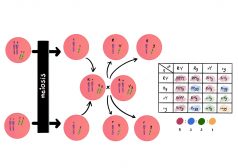Definition
noun, plural: transpositions
(genetics) The transfer of a segment of DNA from one site to another of a chromosome
(general) The state of being removed and transposed from one place to another
Supplement
In genetics, the term transposition refers to the removal and the transfer of a segment of DNA from one site to another of the same or different chromosome. It is different from the transfer of genes from parents to offspring through reproductive mechanisms such as sexual and asexual reproduction (vertical gene transfer). In transposition, the genes are transferred from one organism to another through copying and inserting process. Transposition accounts for the antibiotic resistance and transmission of virulence in certain bacteria.1, 2 The mobile DNA segment that is associated with transposition is called transposon or jumping genes.
Synonym(s):
- horizontal gene transfer (or HGT) (genetics)
- lateral gene transfer (or LGT) (genetics)
Compare:
See also:
- transposon
- transposase
- Blue baby
- Clubbing
- Balloonseptostomy
Related term(s):
Reference(s):
1 Gyles, C; Boerlin P (March 2014). “Horizontally transferred genetic elements and their role in pathogenesis of bacterial disease”. Veterinary Pathology 51 (2): 328–340.
1 Keen, E. C. (December 2012). “Paradigms of pathogenesis: Targeting the mobile genetic elements of disease”. Frontiers in Cellular and Infection Microbiology 2: 161.







